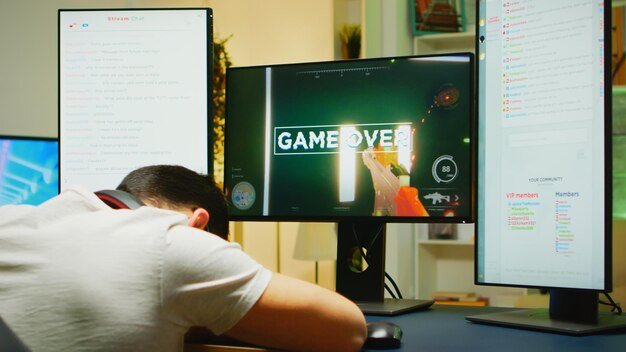
Beginner’s Guide: How to Start Making Your First Game (2024)
Have you ever played a video game and thought, “I wish I could make something like this”? That spark of inspiration is where every great game developer begins. The good news? You don’t need a million-dollar budget or a team of 100 programmers to get started. Creating your first game is more accessible than ever, and this guide will walk you through the entire process, from a blank page to a playable game.
Let’s turn your idea into reality.
Step 1: Start With a Plan (But Keep It Small!)
Your first instinct might be to create the next massive open-world RPG. While that’s an amazing long-term goal, it’s the fastest way to get overwhelmed and give up.
Your first game should be TINY.
Think of a classic like Pong, Snake, or a very simple platformer where you jump over obstacles. The goal isn’t to create a bestseller; it’s to finish a project and learn the entire process.
- Find Your Core Idea: What is the one main thing the player does? (e.g., “Jump,” “Shoot,” “Solve a Puzzle”).
- Write It Down: Jot down a few sentences describing your game. This is your “game concept.”
- Define Your “MVP” (Minimum Viable Product): What is the absolute simplest version of this game that is still fun? Stick to this.
Step 2: Choose Your Game Development Tools
You don’t need to build your own engine from scratch. There are powerful, free tools perfect for beginners:
Game Engines
These are the foundation of your game, handling graphics, physics, and more.
- Unity: Extremely popular and versatile. Great for 2D and 3D games. Has a vast learning community.
- Godot: A fantastic, free, and open-source engine that is rapidly growing. Very user-friendly for 2D games.
- Unreal Engine: Powerful for high-end 3D graphics, but has a steeper learning curve. Best to start with after you have some experience.
Art & Audio Tools
- Graphics: Piskel (free pixel art), GIMP (free alternative to Photoshop), Krita (free digital painting).
- Audio: bfxr (for simple sound effects), Freesound.org (a library of free sounds—check licenses!), LMMS (for making music).
Step 3: Learn the Basics of Design and Code
This is the “learning” phase. Don’t worry; you don’t need to be an expert coder overnight.
- Follow a Tutorial: Find a beginner tutorial for your chosen engine on YouTube. Follow it step-by-step to create a simple game. This teaches you the engine’s workflow.
- Embrace the Fundamentals: You’ll encounter basic programming concepts. The most important ones are:
- Variables: Storing data (e.g., player_health = 100).
- Functions: Blocks of code that perform a specific task (e.g.,
jump()). - Conditional Statements: “If this, then that” logic (e.g.,
if player presses SPACE, then jump).
The key is to learn by doing. Code along with the tutorial, don’t just watch.
Step 4: Build Your First Prototype
Now, take the skills from the tutorial and apply them to your simple idea from Step 1.
- Create a New Project.
- Build a Basic Player Character that can move on the screen.
- Add One Simple Interaction. Can they collect coins? Jump on platforms? Avoid enemies?
- Make a Goal. What defines a “win” or “loss”? (e.g., reach the end, get 10 points, don’t get hit).
Your first prototype will be ugly. Use simple shapes like squares and circles instead of detailed art. This is called “programmer art,” and it lets you focus on the gameplay first.
Step 5: Playtest, Polish, and Iterate
This is the most crucial step for making your game fun.
- Playtest Yourself: Play your own game. Does it feel good? Is it too hard or too easy?
- Show a Friend: Give the game to a friend or family member. Don’t help them. Watch silently where they get confused or frustrated. This feedback is pure gold.
- Iterate: Use the feedback to fix bugs, adjust difficulty, and improve the controls. This cycle of building, testing, and improving is the heart of game development.
Step 6: Add Simple Art and Sound (The “Juice”)
Once the core game works, you can replace your placeholder shapes with simple art. Even basic pixel art or clean geometric shapes can look great. Add sound effects for actions (jumping, collecting) and a simple background track. This “polish” makes the game feel complete and satisfying to play.
Step 7: Celebrate and Share Your Game!
You did it! You finished a game. This is a huge accomplishment.
Now, share it with the world:
- Itch.io is a fantastic platform for sharing small, indie games for free.
- Game Jams (like Ludum Dare) are online events where people make games in a short time frame (e.g., 48 hours). They are a fantastic motivator and a great place to share your work and get community feedback.
Your Journey Starts Now
Making your first game is a challenging but incredibly rewarding experience. You’ll learn problem-solving, creativity, and a valuable new skill set.
Remember, every expert was once a beginner. Start small, be patient with yourself, and most importantly, have fun creating.
What’s the first game you want to make?
Share your ideas and questions in the comments below!


Leave a Reply